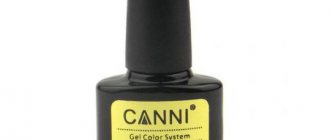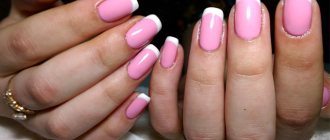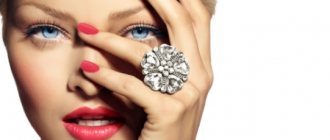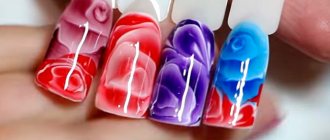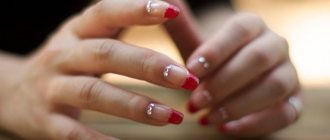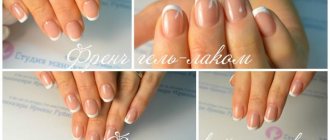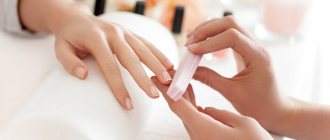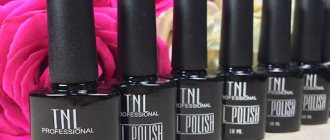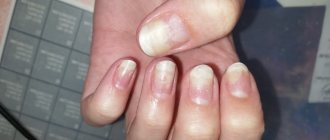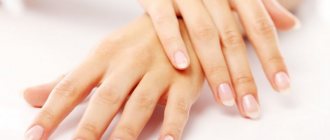A real breakthrough in the field of nail art was the invention of gel polishes. Since that time, women have forgotten about sloppy “peeling” manicures and chipped nails: Gel polishes are loved by millions because they are distinguished by their durability and brightness of colors. With the help of gels, nail extension and correction procedures began to be carried out, and those young ladies who could never boast of the strength of their nails were able to afford incredible experiments with their length and design. Well, the manicure itself has turned into a real work of art. Marigolds have acquired their own style, fashion, and content.
In addition, when using a gel coating, you no longer need to be careful for fear of damaging your manicure. Gel varnishes are resistant to mechanical damage, and moreover, they protect the natural plate from chipping and delamination that occurs under the influence of the environment.
However, not everything is as rosy as it seems at first glance, and gel coating has its own negative consequences, the correction of which sometimes takes more time than you enjoyed with artificial beauty. It’s worth talking in detail about the consequences of an insatiable passion for artificial manicure and how to restore nails after gel coating.
Strengthen nails
Our nail plate consists of keratinocytes, which make up its frame. They are like roofing on a roof. When the gel manicure is removed, the top layer of the protective “roof” is also removed. Therefore, nails become weak and brittle.
Your task is to strengthen their frame. This requires special medicinal varnishes, BB nail creams, serums with calcium and vitamins. Therapy may take two weeks. During this time, you cannot do a gel manicure or use regular nail polishes.
Is gel nail polish harmful?
This is actually a myth! Gel polish does not damage the nail plate in any way. Then why do girls complain that after artificial coating the quality of their nails becomes much worse? It's all about violating the technique of manicure and removing gel polish, as well as wearing the coating for a long time. Unfortunately, this can lead to consequences such as:
- thinning of the nail plate;
- lamination and fragility;
- injury to the nail plate;
- painful sensations when touching the nail plate;
- onycholysis;
- fungal nail diseases.
Who is to blame for this? Sometimes it’s a non-professional manicurist, and sometimes it’s the manicure owners themselves. But not the material! So the assumption that gel polish spoils nails is a myth.
Why do all the above problems arise and how to restore the nail plate after them? Let's figure it out.
Take care of the cuticle
When gel polish is dried under a UV lamp or removed with a special liquid, wrapping the nails in foil, this greatly dries out the cuticle. But underneath there is a soft nail (the living part of the plate), which requires nutrition.
For moisturizing, hand creams and serums with allantoin and collagen are suitable, as well as cuticle oils based on apricot or olive with vitamins (primarily vitamin E). Oils not only moisturize it well, but also nourish the soft nail, stimulating the growth of strong and healthy nails. After applying oils, massage the cuticle area.
Once a week at night it is recommended to wear hand masks (they are sold in cosmetic stores). They deeply nourish and moisturize the cuticle and skin of the hands. The main thing is not to cut the cuticle, so as not to damage it.
Why does onycholysis and nail fungus occur after gel polish?
Onycholysis is a disease characterized by the separation of the nail plate from the nail bed. May be infectious or non-infectious. The consistency and color of the nail plate does not change with non-infectious onycholysis. But with an infection, it becomes cloudy and rough. In 60% of cases, onycholysis is a consequence of traumatic injury, in 30% - a consequence of mycosis (fungus). How does this relate to manicure and what are the causes of onycholysis after gel polish?
- If the manicure technique is violated, the master can injure the nail plate with tools, as well as cause a burn;
- When using a non-sterile instrument during operation, an infection or fungi may develop on the nail;
- Excessive squeezing can lead to injury to the nail. This problem is more common in pedicures in cases where the master uses a hard rather than elastic base, or the client wears narrow, constricting shoes.

You might think that the cause of onycholysis is solely manicure, but this is not so. Onycholysis also appears against the background of:
- dermatological problems;
- endocrine disorders;
- pathologies of the digestive tract;
- allergic reactions.
Fungal diseases appear not only with onycholysis. They may be accompanied by a change in the color of the nail, such as turning green. If we consider these diseases from the point of view of manicure and pedicure, then the main reason is the use of unsterile instruments. So take your choice of a hairdresser or beauty salon seriously! But even here you need to understand that the fungus does not always appear due to the fault of the master. It can occur through contact with a sick person or with objects contaminated with spores.
Go through salon treatments
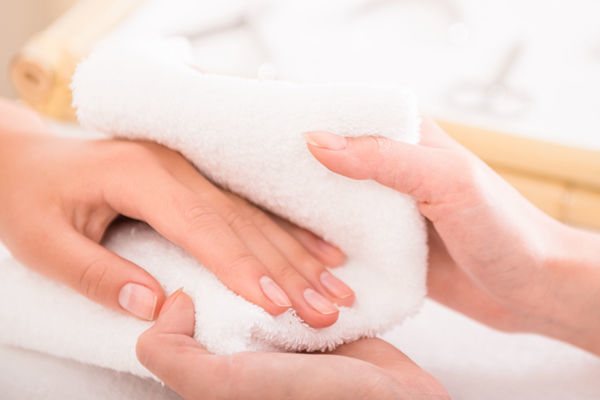
If the situation with your nails is completely deplorable (they break almost from a blow of wind), you should contact a specialist. There are a number of salon procedures that strengthen nails well, and at the same time improve the condition of the skin of the hands.
For example, a preparation based on honey and beeswax is applied to the nails; the substance forms a protective film on the surface of the nail plate (simulating a layer of keratinocytes). The procedure must be repeated several times over two weeks to achieve the effect.
Chocolate wrap is even nicer and healthier for nails: melted chocolate is applied to the nails and skin of the hands for 20-30 minutes. Cocoa butter nourishes the skin and restores damaged nail plates, while you enjoy the aroma.
How long can you wear gel polish?
Technologists advise walking with the coating for no more than 2-3 weeks. But often girls wear gel polish for a month, or even longer. However, they do not understand that they can damage the nail plate. Prolonged wear puts stress on the tip of the nail plate, its root suffers from the weight of the coating. And this can lead not only to breakage, but also to deformation of the nail plate.
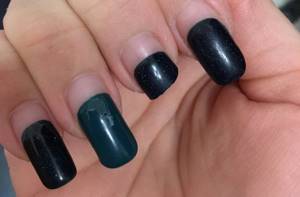
Apply paraffin

This procedure can be done both in the salon and at home. Paraffin is heated in a bath to 40 degrees. Then the hands are placed there, then they are wrapped in plastic and wrapped with a towel on top. You need to wait 15-20 minutes and then remove the paraffin mask. The procedure helps strengthen nails, smoothes the skin of the hands, and slows down the aging process.
Expert opinion
— The belief that nails deteriorate under gel coatings came to us from the 2000s. And then it was justified: when doing extensions, the masters cut off three to five lipid layers and dried the nails using special means (acid primers and bonds).
The nail industry does not stand still. Over the past 18 years, the approach of craftsmen to their work has changed, and the materials have become better. When working with gel and gel polish nowadays, preparation of the nail plate is minimal, all lipid layers remain intact. The adhesion of the gel (gel polish) and the nail plate is brought to a high level. The use of special means is required only in particularly difficult cases, for example, with hyperhidrosis (increased sweating).
Unfortunately, gel coatings are still not suitable for everyone; 15-20% of people are forced to look for an alternative. As a rule, this occurs due to the individual characteristics of the body: hyperhidrosis, hormonal imbalance, pregnancy, menopause, allergies.

Polina Nazaretyan , nail expert and co-founder of Nails Russia studios
Taking vitamins
An alternative to diet is taking vitamins in medicinal form. Preference should be given to vitamins A, E, B5. Vitamins A and E are sold in capsule form, vitamin B5 in tablet form. But there are also vitamins in the form of ampoules. It is recommended to apply these solutions directly to the nails.
As part of complex therapy, it is recommended to take vitamin D in combination with calcium. In the pharmacy you can find dietary supplements that are designed specifically to strengthen nails and contain the entire necessary complex of vitamins and microelements.

There are special multivitamin complexes that will improve the condition of your nails.
Among them:
- Amway,
- Revalid,
- Fitoval,
- Vitrum Beauty,
- Oriflame Hair&Nail NutriComplex,
- Merz,
- Perfectil and others.
Sesame oil for growth and strengthening
It is not for nothing that sesame oil is recommended to be rubbed into nails.
It promotes:
- strengthening the nail plate;
- getting rid of fungus;
- increasing the elasticity of the nail;
- preventing brittleness and delamination.
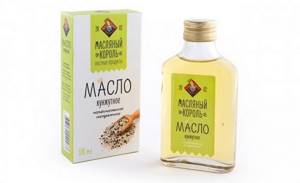
Sesame oil nourishes the nail plate well.
Doctors advise taking warm 10-minute baths with lemon juice before applying sesame oil, and then rubbing the oil into each nail plate with massage movements.
The need for prosthetic nails on the hand or foot

Prosthetics are necessary in the following cases:
- The plate was destroyed due to fungus.
- In case of delamination.
- If, due to injury, nail growth and development stop or are disrupted.
- In the presence of congenital defects (plate in the form of a spoon).
- After nail surgery.
- During ingrowth.
- In case of longitudinal or transverse splitting of the plate.
- In order to create additional space for ingrown nails.
- In case of growth disturbance.
Since fixation of artificial material on the skin is impossible, high-quality prosthetics require that at least a third of the natural plate be preserved. If the nail is completely absent or its size is smaller than necessary, the prosthesis will be unstable, and there is a high probability of damage to the nail in the matrix area.

Before prescribing prosthetics to a patient, the specialist must find out what factors predispose him to this procedure. In addition, he clarifies the presence of contraindications, which include:
- pathologies leading to damage to the nail plate;
- presence of wounds;
- psoriasis;
- diabetes;
- inflammatory process in the ridges located near the plate.
The podologist must first study the characteristics of the patient’s body, take into account the initial circumstances and, based on this, select a more effective and aesthetic way to solve the problem with an ingrown toenail.
Celandine oil for fungus
Before applying the oil, it is recommended to wash your feet or hands well with laundry soap and steam them in a bath. Add soda, vinegar or lemon juice to the water. These components have antimycotic properties.
After which the nails should be treated by removing the top most damaged layer of the nail using a nail file.
This is done so that the oil penetrates deeper into the nail plate. After this, the oil is applied using a pipette to each nail. The procedure is carried out before bed every day. The healing properties of the oil are enhanced if applied warm.
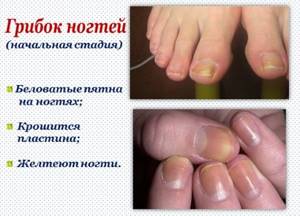
Nail fungus must be recognized early to minimize damage
The process looks something like this:
- 1 tbsp. Celandine oils should be mixed in equal proportions with medical alcohol and left to infuse for a day.
- Next, you need to moisten a cotton swab and apply 5-minute applications on each nail.
- Each finger on which the product is applied must be wrapped in cling film.
- After 5 minutes, the composition is removed with a paper napkin.
Use the product daily, preferably after a steam bath. Squeeze the juice out of a whole lemon and add 1 tbsp to it. celandine oils. Make a compress from the resulting mixture on fingernails or toenails damaged by fungus, and wrap it with cling film on top. After 20 minutes, wash off the product.
Traditional methods for strengthening nails
- It is enough to dissolve sea salt in warm water : 1 tbsp. per 100 ml of water to prepare a strengthening bath for nails. Dip your fingers into the liquid for 10 minutes. Then wipe your nails with lemon juice. You can add a few drops of juice or essential oil directly to the bath. Lemon whitens, and salt strengthens the nail plate. With systematic use of the product, nails will grow faster and stop peeling.
- After any baths, it is recommended to lubricate your nails with olive oil.. It adds shine to the nails, moisturizes them, thereby increasing the elasticity of the nail. Baths are also prepared from the oil: you need to heat the oil in a water bath, add liquid from 3 capsules of vitamin A and 3 drops. alcohol solution of iodine. After holding your fingers in this solution for 20 minutes, you need to blot them with a paper napkin to remove excess oil. You cannot wash your hands after this for 2-3 hours.

There are many recipes that can solve certain nail problems. - Combine 3 tbsp. 9 percent vinegar and 100 ml olive oil. Heat the mixture in a water bath. Dip your fingers into the mixture for 15 minutes and wipe with a paper towel.
- 3 tbsp. dried arnica flowers pour 1 tbsp. just boiled water, leave for 20 minutes. Then drain the liquid and add 3 tablespoons to it. olive oil and 3 drops. alcohol solution of iodine. Dip your fingers into the container for 10 minutes. After the procedure, wipe off the oil with a paper napkin. Do not expose hands to water for 1-2 hours.
- Fresh cucumbers are grated on a fine grater and the juice is squeezed out. You will need 100 ml of liquid. Add to it 100 ml of beer and 1 tbsp. salt. Take a bath for 15 minutes.
- In 1 tbsp. Dissolve 2 tsp in hot water. gelatin. Wait about 40 minutes for it to swell. Then heat the liquid to 40 degrees and immerse your fingers in the solution for 15 minutes. After the bath, rinse your hands with water. Make a bath every other day for 2 weeks.
Recipes to improve color
- 3 tbsp. dried orange flowers mixed with 1 tsp. lemon juice. Leave for 20 minutes and then use as a rub.
- A wax mask helps improve color and thicken nails. Melt the wax in a water bath. Carefully dip your fingers into the liquid mass. The wax may be too hot. To allow the wax to harden, immediately rinse your hands with cold water. Why wear fabric gloves? The procedure must be carried out at night and leave the wax mask on the nails until the morning.
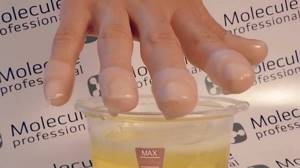
A wax bath may look weird, but the results are worth it. - 0.5 tbsp. Potato peelings (the potatoes must be washed first) are mixed with flaxseed and beer in equal proportions and boiled until the solid ingredients are softened. The resulting mass is used as a compress on the nails, applying it for 15 minutes.
- To remove yellowness from your nails, just wipe them with juice or the inside of a lemon peel. But you shouldn’t use this technique too often, because lemon juice will dry out your nails.
IBX system
The IBX system is a special two-phase product that is unlike any other. In release form, it resembles nail polish, but penetrates much deeper into the nail and restores it from the inside. So deep that it is impossible to remove the coating.
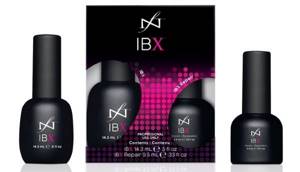
The IBX system has extremely positive results
First of all, a composition is applied that stimulates nail growth, then one that levels the surface of the nail, filling in unevenness and connecting the exfoliated plates.
If your nails are too brittle, peeling, thinned, or covered with grooves or spots, it is especially recommended to use this treatment method. In its action, the IBX system is equivalent to a salon procedure and is often carried out in manicure salons, but it can also be performed at home.
Result after use:
- the nail plate is strengthened;
- the structure is restored from the inside;
- growth accelerates;
- nails stop peeling;
- external defects become less pronounced.
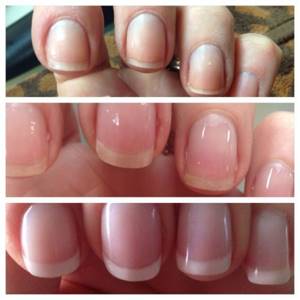
Progress of nail restoration using the IBX system
The composition can be used during pregnancy, as it does not contain harmful substances, and can be used constantly, as a base for nail polish or gel extensions. The effect is noticeable immediately after use.
Main disadvantages:
- high price;
- the need to use a UV lamp.
Despite the exceptional results, the procedure itself takes only 10 minutes.
This is done as follows:
- Nails should be tidied up and given the desired shape.
- Then the plate must be degreased with an alcohol-containing liquid.
- Then the product for the first stage should be applied exclusively to the nail plate. The bottle with the product is shaken beforehand.
- Immediately the coating must be heated with a stream of hot air (for example, a hairdryer).
- Next, remove the sticky layer with a lint-free cloth and dry the coating in a UV lamp for 1-2 minutes.
- Degrease the nail plate.
- Next, apply the second step product.
- The coating is heated again with a stream of warm air.
- Remove the sticky layer again, but dry the coating under the lamp for 5 minutes.
- Degrease the nail. If the coating is applied for the first time, then you need to cover the nails again with the second product, if not, then this is the last step.
If the product is applied as a base, then a manicure with gel polish or extensions can be done on top of it. The worse the condition of the nails, the more often you should use the product: from 1 to 4 times a month. In an effort to improve the condition of your nails, you should not abuse the product by using it too often or applying more layers.
Causes leading to injury and wear of the nail plate
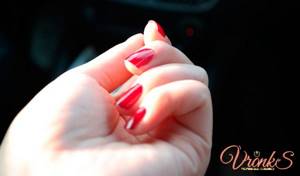
1. Stress - As soon as it enters our lives, in 2-2.5 months someone’s hair will fall out, someone’s nails will suddenly begin to peel, or maybe both together.
2. The genetically specified thickness of the nail depends on the length of the matrix; the longer the matrix, the thicker the nail; with dystrophies or injuries of the matrix apparatus, part of it can be completely lost, as a result of which the nail becomes thinner. If the nail plates become rough or “peel off” in thin strips during treatment, harsh nail polish removers are to blame because they eat away the natural protective keratin layer.
3. Very often, thick, concentrated dishwashing detergents (Ferry) severely delaminate the nail plate.
4. Now about 40% of the population suffers from vegetative-vascular dystonia (constant cold hands and feet). Due to poor blood supply to the extremities, the nutrition of the nails is disrupted, which means growth slows down. People with this problem need to massage their hands and feet every day.
5. We must not forget that nail extensions/removal should only be performed by a professional nail technician, but sometimes it happens that, due to lack of time, the necessary time is not maintained to remove the artificial material and the upper scales are torn off, resulting in the formation of damage and microcracks on the surface of the nail.
How does the nail plate adhere to the material?
With the help of chemical-physical adhesion: with physical adhesion, we ourselves buff the nail plate so that the material adheres to the scales of the nail and thereby thins it; with chemical adhesion, the material adheres to the nail plate using chemical reagents (bondex and primers, which themselves leach and dry out the nail plate).
In both cases, the material penetrates deeper into the surface layer of the nail plate the older the client is (with age, nails often become more porous, resulting in shrinkage of the gels). In this case, it is more difficult to remove the material from the nail plate and it is recommended to make corrections with a cutter.
On the nail industry market there is a Soft gel material, in which adhesion works on the principle of adhesive tape and in this case, the removal of the material occurs quickly and not traumatically.
How to restore a nail plate?
It is necessary to stimulate its growth, provide blood flow to the nail plate, thereby increasing the rate of fusion, while it must be constantly trimmed, because nails often lose their vitality and become brittle.
It takes patience and time. To do this, it is better to carry out an enhanced procedure to restore them, fill them with vitamins, microelements, and oils.
There are a huge number of nail restoration products on the nail service market. When choosing products, you need to pay attention to the constituent components, preferably in composition they should be close to the nail plate, i.e. look at the presence of sulfur, zinc, selenium, and silk proteins in them.
Accelerates nail growth - hormonal changes (adolescence, pregnancy, premenstruation), spring time.
Growth is slowed down by an overly strict diet low in fat, proteins and vitamins, diseases accompanied by circulatory and metabolic disorders, stress, and the habit of biting nails.
Due to the layered and porous structure of the nail, 2 2 simultaneous processes occur in it, characteristic of the skin itself - absorption and sweating, unlike the skin, these processes occur passively in the nails since they lack regulatory mechanisms.
Due to their high permeability, nails produce up to 12% of skin effusion per day and also absorb everything that is on their surface, they actively absorb water that the skin does not absorb, various methods of treatment and restoration of nails are based on this.
